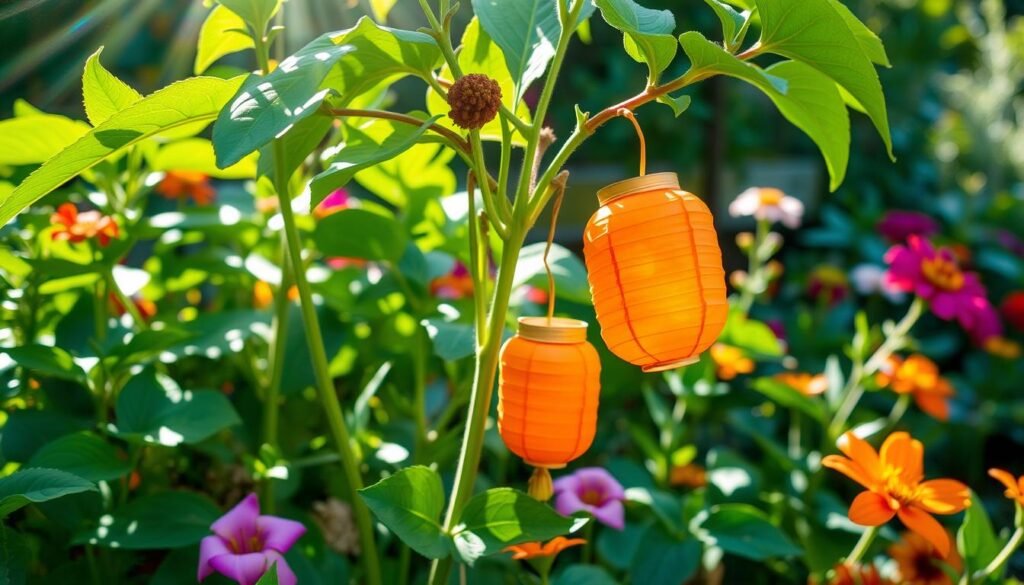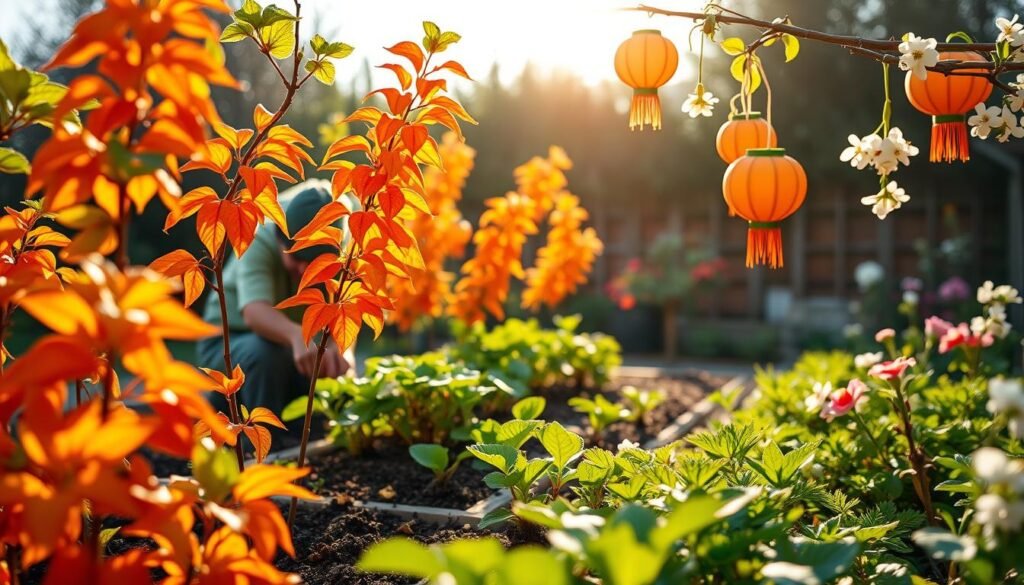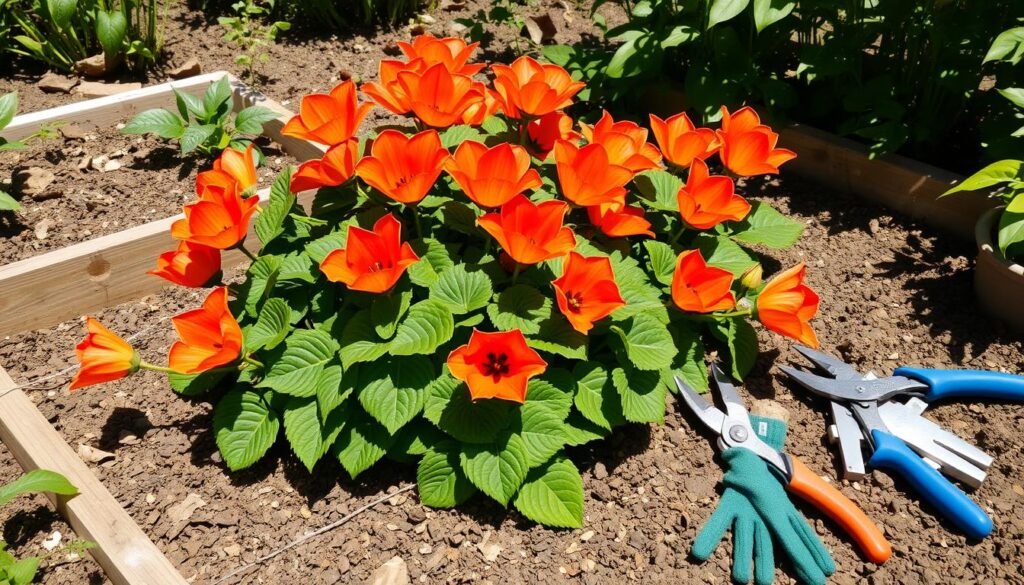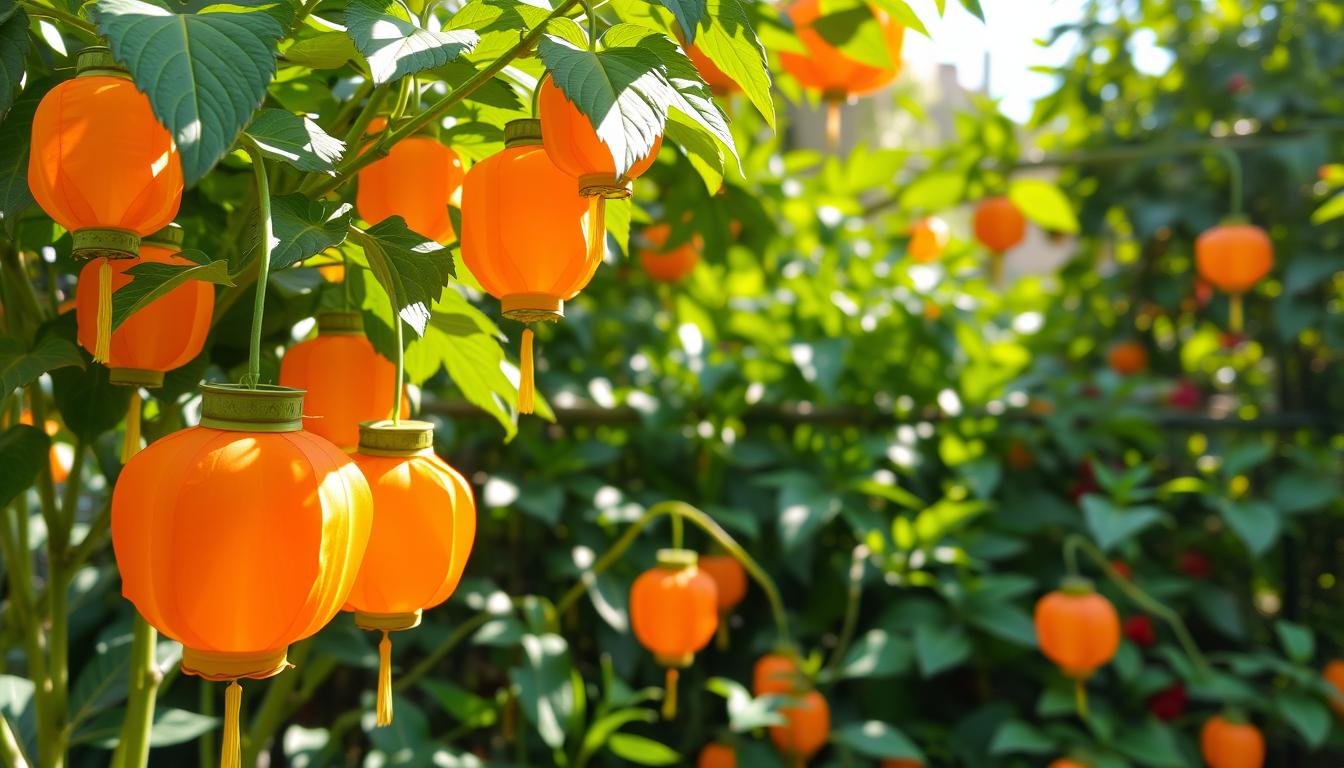The Chinese lantern plant, known as Physalis alkekengi, is a beautiful addition to gardens. Its bright orange seed pods stand out, making it a highlight in the fall. But, it’s important to know that the berries and leaves are toxic to humans and pets.
To make sure your plant thrives, you need to take good care of it. This guide will show you how to grow and care for the Chinese lantern plant. You’ll learn how to manage its growth and enjoy its beauty every year.
Table of Contents
Introduction to the Chinese Lantern Plant
The Chinese lantern plant, known as Physalis alkekengi, is part of the Solanaceae family. This family also includes tomatoes and eggplants. The plant is famous for its bright, papery husks that add beauty to gardens.
For gardeners wanting to grow this plant, knowing about introduction to physalis is key. These plants love full sun and need at least 6 to 8 hours of sunlight a day. They grow best in USDA zones 3 through 9, where temperatures are between 60-75°F (15-24°C).
Soil quality is important for the plant’s health. It needs rich, well-draining soil with a slightly acidic to neutral pH. Keeping the soil moist helps the roots grow and prevents root rot from too much water.
There are two ways to propagate the plant: through seeds or division. Starting seeds indoors 6-8 weeks before the last frost is a good idea. For more gardening tips, check out this gardening guide.
Characteristics of the Chinese Lantern Plant
The Chinese lantern plant, known as physalis alkekengi, has unique features. These make it stand out in any garden. Knowing its characteristics helps us appreciate it and grow it well.
Common Names and Botanical Classification
This plant is also called winter cherry and ground cherry. It belongs to the Physalis genus, with about 90 species in North and South America. The Chinese lantern is the only wild species in central Europe.
Size and Growth Habits
The Chinese lantern plant grows 12 to 39 inches tall and 12 to 16 inches wide. It’s a hardy perennial that spreads aggressively. Without control, it can take over your garden, so boundaries or containers are key.
Appearance and Bloom Time
The plant has 3-7 heart-shaped leaves with autumn colors. It blooms in July with small, white flowers. By September, the orange seed pods add a striking look to your garden.
The fruits of physalis alkekengi add beauty to bouquets, flowerbeds, or cottage gardens. They symbolize cultural richness, like during China’s Lantern Festival. Learn more about similar plants at this link.
Optimal Growing Conditions
To grow a healthy Chinese lantern plant, knowing the best conditions is key. This includes light, soil, temperature, and humidity. These factors help the plant thrive and grow well.
Light Requirements for Healthy Growth
Chinese lantern plants love lots of sunlight. They need 6 to 8 hours of bright light daily. This helps them grow strong and bloom brightly.
In very sunny places, some afternoon shade is good. It prevents the leaves from getting scorched. This keeps the plant healthy during hot months.
Soil Preferences and pH Levels
Chinese lantern plants prefer soil that drains well. This can be chalk, loam, or sand. The best pH level is between 6.6 and 7.3.
While rich soil helps them grow fast, it can cause them to spread too much. To control this, growing them in containers is a good idea. It helps manage their growing roots.
Temperature and Humidity Considerations
The ideal temperature for Chinese lantern plants is around 70°F during the day. At night, they should stay above 55°F. They don’t need specific humidity levels, but planting after the last frost helps.
This ensures they don’t die back in winter. Creating the right environment helps your garden flourish.

Planting Your Chinese Lantern Plant
Planting your Chinese lantern plant right is key. Knowing when and how to plant helps your plant grow well. You can choose between seeds or transplants, depending on what you like. Here’s what you need to know about timing and starting your plants.
When to Plant: Timing and Season
The best season for the Chinese lantern plant is spring, after the last frost. This ensures your plants grow strong before it gets too hot. Planting too soon can harm your plants from frost.
Start your seeds indoors 6 to 8 weeks before the last frost. This gives them a head start. Move them outside after the frost. Or, you can sow seeds directly in the garden after the frost.
How to Start from Seeds or Transplants
You can start your Chinese lantern plants with seeds or transplants. If using seeds, spread them on the soil and cover lightly. Keep the soil moist to help them grow, which takes about two weeks.Watering is key to prevent drying out. But don’t overwater to avoid rot.
For transplants, make sure they get used to outdoor weather before planting. Keep daytime temperatures between 70 to 75 degrees Fahrenheit for best growth. The right timing and method will help your plants bloom beautifully in their first season.

| Method | Timing | Notes |
|---|---|---|
| Starting Seeds Indoors | 6-8 weeks before last frost | Maintain soil temperature between 60-70°F |
| Sowing Seeds Outdoors | After last frost | Cover seeds lightly and keep moist |
| Transplants | After last frost | Acclimate to outdoor conditions gradually |
Chinese Lantern Plant Care
Taking care of your Chinese lantern plant means paying attention to watering, fertilizing, and pruning. Following the right watering guidelines and maintenance tips can make your plants healthier and more productive. Knowing how to manage moisture, fertilization, and pruning will help you get the best results in your garden.
Watering Guidelines for Consistent Moisture
The Chinese lantern plant does best when its soil is consistently moist but not too wet. It’s important to water it well, but not too much, during dry times. Water about 0.5 cups every 9 days if it’s not in direct sunlight. Let the soil dry a bit before watering again to avoid root rot and ensure it gets enough moisture.
Fertilization Tips and Recommendations
For fertilizing, a balanced fertilizer in spring can help your Chinese lantern plant grow. Use it sparingly to avoid too much growth and spreading. Watch your plant’s health to see if it needs more nutrients, like when it doubles in size and needs a new pot.
Pruning and Maintenance Strategies
Pruning isn’t always needed, but a light cutback at the end of the growing season can help it grow better next year. Keep the plant’s shape and prevent it from spreading too much. Don’t do major pruning when it’s blooming to keep the beautiful fall pods. Good maintenance and care will keep your Chinese lantern plants looking great.

| Care Aspect | Recommendation |
|---|---|
| Watering Frequency | Every 9 days |
| Soil Moisture | Allow to dry out slightly between waterings |
| Fertilization | Sparingly in spring with balanced fertilizer |
| Pruning | Light cutback at end of the growing season |
| Repotting | After growth doubles or annually |
By following these care tips, you can have a garden full of beautiful Chinese lantern plants. For more details, check out this guide on caring for your Chinese lantern plant.
Controlling Growth and Spread
To stop invasive growth of the Chinese lantern plant, we need to act early. We must manage the rhizomes well to stop them from spreading. Regular checks help us catch and remove any new shoots quickly.
Managing Invasive Growth and Rhizomes
Chinese lantern plants spread through underground rhizomes. It’s key to use good containment strategies. Here are some ways to do it:
- Regularly inspect the garden for new shoots
- Remove unwanted growth right away
- Use ground barriers to stop rhizome spread
Using these methods keeps your garden looking great. For more care tips, check out this helpful resource.
Potting as a Solution to Containment
One great containment solution is to grow in pots. Pots limit the plant’s spread and make it look better. Choose pots that are at least 12 inches (30 cm) wide. This way, the Chinese lantern can grow well without spreading too much.

| Benefit | Description |
|---|---|
| Control | Regulates plant size and prevents spread. |
| Mobility | Allows for easy relocation based on sunlight or aesthetics. |
| Disease Management | Easier to monitor and manage pests or diseases. |
| Soil Quality | Provides greater control over soil conditions and fertility. |
By understanding how to manage invasive growth and using pots, we can enjoy the beauty of Chinese lantern plants. They can be a great addition to our gardens, not a problem.
Pests and Diseases to Monitor
Keeping your Chinese lantern plants healthy means watching out for pests and diseases. These can harm your garden. It’s important to spot problems early to treat them and keep your garden looking great.
Common Insect Pests Affecting the Plant
Chinese lantern plants can get attacked by pests like cucumber beetles and flea beetles. Regular checks are key to catching these pests early. Using neem oil or insecticidal soap can help control them and keep your garden healthy.
Preventative Measures Against Fungal Diseases
Fungal diseases can harm your Chinese lantern plants. To prevent this, make sure plants have enough space. This helps air move around and reduces disease risk. Also, remove any sick leaves quickly to protect your plants and garden.
Harvesting and Utilizing Chinese Lantern Pods
The Chinese Lantern plant is not just beautiful; its pods can also decorate your home. Wait until the pods turn a mature orange to reddish-orange color. This usually happens in late summer or early fall.
After you’ve picked the right number of pods, it’s important to handle them right. Use good preservation techniques to keep them looking great for months. Cut the stems at ground level and hang them upside down in a dry, dark, and well-ventilated place.
Once they’re dry, you can use them in many creative ways. They’re perfect for making stunning arrangements or unique Halloween decorations. Their vibrant color and interesting texture will add warmth and flair to your home. For more tips on harvesting and preserving these plants, check out this link.



